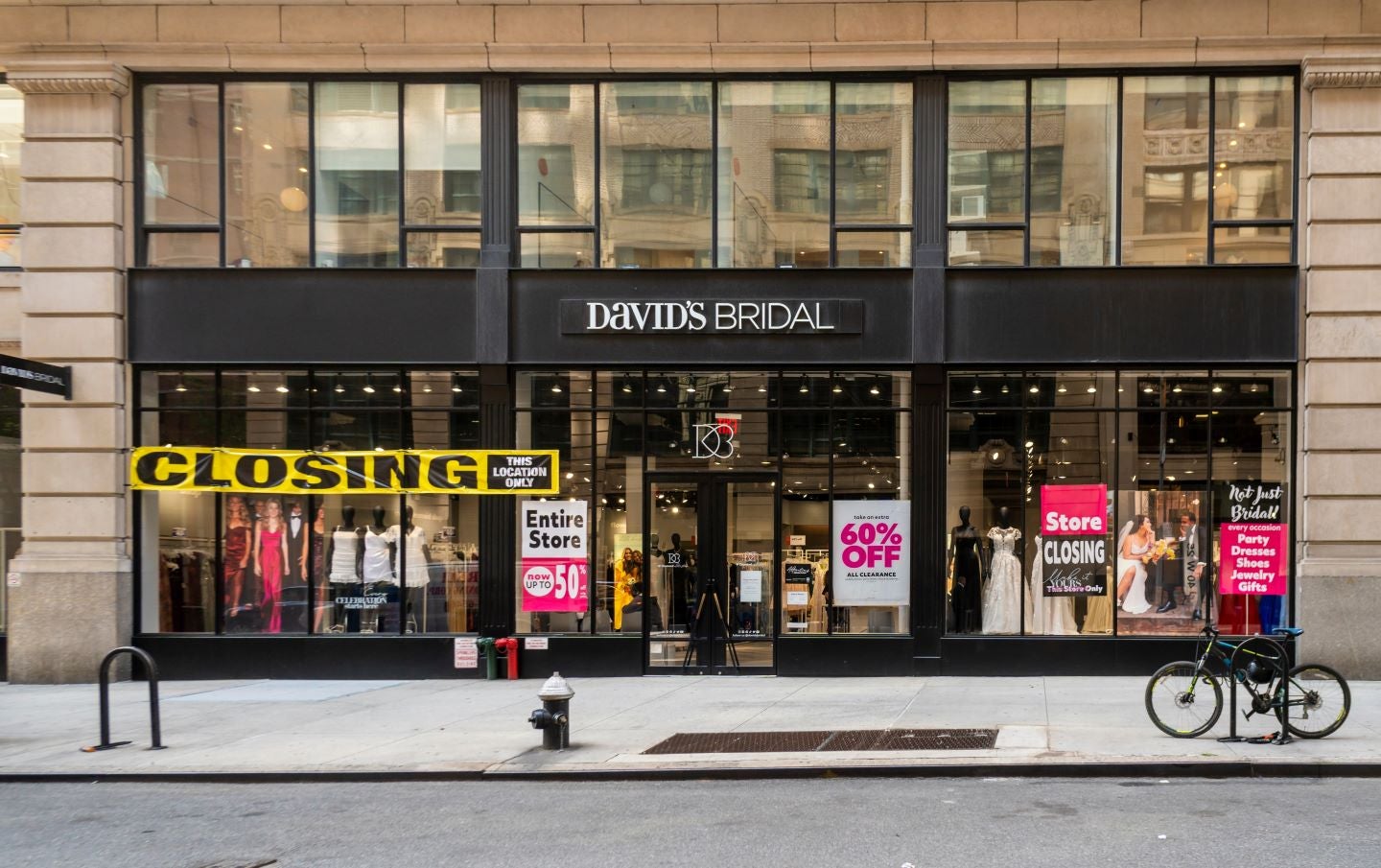
Each week, Just Style’s editors select a deal that illustrates the themes driving change in our sector. The deal may not always be the largest in value, or the highest profile. But we select it because of what it tells us about where the leading companies are focusing their efforts, and why. We pick apart the deal itself, and the industry theme behind it. This new, thematic deal coverage is driven by our underlying Disruptor data which tracks all major deals, patents, company filings, hiring patterns and social media buzz across our sectors.
Inside the David’s Bridal deal
Business development company Cion Investment Corp has executed a non-cash transaction to acquire the assets of David’s Bridal, preventing a total shutdown of the wedding gown retailer.
The move follows David’s Bridal – a chain of 300 stores in the US according to its website – filing for Chapter 11 bankruptcy in April for a second time in less than five years. It confirmed it would move to file a recognition proceeding in Canada and a subsidiary of David’s Bridal was expecting to commence an administration proceeding for its business in the United Kingdom.
The announcement came just under four years of the wedding dress retailer securing a $55m capital injection which it would use to fund growth investments on top of an agreement with its lenders to exchange $276m of its existing term loans into new preferred and common equity securities.
The plan was to use the financial resource and flexibility to focus on changing the David’s Bridal experience. This included modernising branding and marketing, investing in tools and platforms to support brides during the entire wedding planning process, and enhancing the customer experience in-stores and online.
After the company filed for bankruptcy protection, James Marcum, CEO of David’s Bridal, said while the company had taken “meaningful strides” to transform and fulfil the needs of its customers, modernising its marketing and interaction processes, the business continued to be challenged by the post-Covid environment and uncertain economic conditions, leading it to consider selling to a buyer able to operate the business going forward.

US Tariffs are shifting - will you react or anticipate?
Don’t let policy changes catch you off guard. Stay proactive with real-time data and expert analysis.
By GlobalDataLast week a US court approved the sale of its assets to Cion Investment Corp.
Here’s why the deal matters
The no-cash sale will decrease the debt of David’s Bridal from $256.9m to $50m, according to Reuters.
And the deal will save more than 7,000 jobs and up to 195 locations.
Reuters reports Cion will keep the stores open, and pay certain debts, as well as the costs of renewing and breaking leases at retail locations, and certain fees associated with bankruptcy.
Neither David’s Bridal nor Cion responded to requests for comment when approached by Just Style.
Speaking to Just Style exclusively, GlobalData apparel analyst Louise Deglise-Favre said: “David’s Bridal has had a tumultuous history, filing for bankruptcy multiple times in the last decade. While David’s Bridal blamed its recent financial struggles on a difficult post-pandemic trading environment, it seems the brand had other deeper structural issues. The wedding boom experienced in 2022 after the backlog that had formed following two years of Covid restrictions saw the introduction of many bridal lines by traditional brands and the sector generally experienced high demand, making David’s Bridal’s difficulties all the more surprising.”
Key takeaways for the fashion industry
The fashion industry has been flooded with bankruptcy announcements, particularly since the turn of the decade when the Covid pandemic hit. And while the likes of retailers J.C Penney, Neiman Marcus and Tailored Brands all announced they were filing for bankruptcy protection in the US, UK businesses were not immune to the struggles with household names including department store Debenhams collapsing into administration.
Debenhams was subsequently acquired by fast fashion e-tailer Boohoo, which shut all physical locations turning it into a digital-only brand to lower costs and create greater efficiencies.
Similarly, rival fast-fashion firm Asos, acquired the assets of the once High Street staple, Arcadia Group which owned the Topshop, Topman, Burton’s and Miss Selfridge brands. Again this saw the closure of all physical locations.
Sometimes fresh blood is all it takes to turn the misfortune of a company around. One that commonly surprises is technology brand Apple which was on the brink of collapse in the late 1990s following financial uncertainty, failed products and stiffening competition. A $150m investment from Bill Gates helped the brand recover to today becoming the most valuable brand in the world.
On the fashion front, footwear brand Converse filed for bankruptcy in 2001 and was subsequently acquired by sportswear brand Nike for $1.9bn according to the New York Times . In fiscal 2023, Converse delivered revenues of $2.4bn up 3% on a reported basis and up 8% on a currency-neutral basis, led by double-digit growth in North America, partially offset by declines in Asia.
Deglise-Favre concludes: “The change in ownership should bring a change in strategy and a rebalancing of its [David’s Bridal’s] finances, hopefully allowing the brand to return to growth.”
More research:
Apparel Industry Mergers and Acquisitions Deals by Top Themes in Q1 2023 – Thematic Intelligence



